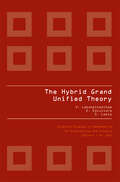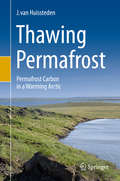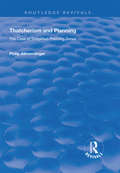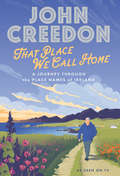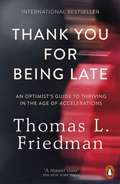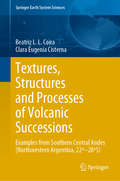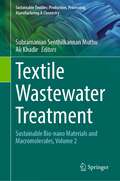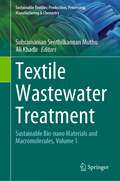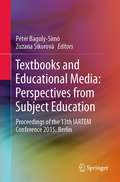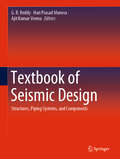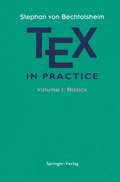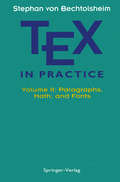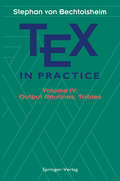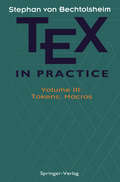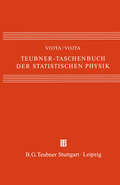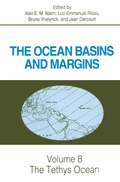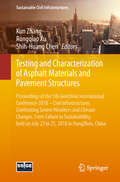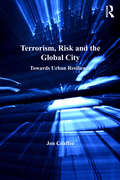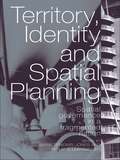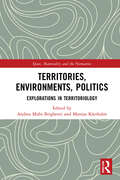- Table View
- List View
THE HYBRID GRAND UNIFIED THEORY (Atlantis Studies in Mathematics for Engineering and Science #3)
by E. Escultura V. LakshmikanthamIn this book, an attempt is made to provide a hybrid grand unified theory to understand the universe, both in its micro/quantum aspects as well as macro/galactic aspects. The book describes a truly hybrid theory as it encompasses both the modern and ancient theories of the universe, together with its functioning at all levels of human comprehension. One of its authors, Dr Escultura, was nominated in 2005 for a Nobel Prize for his flux theory of gravitation. From then on this theory has been improved, clarified and is now known as the hybrid grand unified theory. This book deals with this new bold theory, unifying mathematics and physics, and answering some open fundamental questions and paradoxes in these disciplines. The book also describes what the ancient scientists knew about these matters.
Thawing Permafrost: Permafrost Carbon in a Warming Arctic
by J. van HuisstedenThis book provides a cross-disciplinary overview of permafrost and the carbon cycle by providing an introduction into the geographical distribution of permafrost, with a focus on the distribution of permafrost and its soil carbon reservoirs. The chapters explain the basic physical properties and processes of permafrost soils: ice, mineral and organic components, and how these interact with climate, vegetation and geomorphological processes. In particular, the book covers the role of the large quantities of ice in many permafrost soils which are crucial to understanding carbon cycle processes.An explanation is given on how permafrost becomes loaded with ice and carbon. Gas hydrates are also introduced. Structures and processes formed by the intense freeze-thaw action in the active layer are considered (e.g. ice wedging, cryoturbation), and the processes that occur as the permafrost thaws, (pond and lake formation, erosion).The book introduces soil carbon accumulation and decomposition mechanisms and how these are modified in a permafrost environment. A separate chapter deals with deep permafrost carbon, gas reservoirs and recently discovered methane emission phenomena from regions such as Northwest Siberia and the Siberian yedoma permafrost.
Thatcherism and Planning: The Case of Simplified Planning Zones (Routledge Revivals)
by Philip M. AllmendingerFirst published in 1997, this volume explores how, seventeen years after the election of the first Thatcher government, it is clear that despite the attacks, land use planning has survived. Talk during the 1980s of the death of planning and a bonfire of controls seem in hindsight distant and alarmist. Planning now has a new lease of life and is once again firmly on the government’s agenda. So what happened during the 1980s? How did planning come to experience such a radical change in fortune? Philip Allmendinger explores the impact and influence of the New Right’s intentions for planning through arguably the most Thatcherite approach of all: Simplified Planning Zones (SPZs). In doing so he identifies the contradictions and confusion at the heart of Thatcherism that led to vague legislation and objectives allowing localities to interpret Thatcherism for themselves often using policies such as SPZs for reasons very different than those intended.
Thatcherism and Planning: The Case of Simplified Planning Zones (Routledge Revivals)
by Philip M. AllmendingerFirst published in 1997, this volume explores how, seventeen years after the election of the first Thatcher government, it is clear that despite the attacks, land use planning has survived. Talk during the 1980s of the death of planning and a bonfire of controls seem in hindsight distant and alarmist. Planning now has a new lease of life and is once again firmly on the government’s agenda. So what happened during the 1980s? How did planning come to experience such a radical change in fortune? Philip Allmendinger explores the impact and influence of the New Right’s intentions for planning through arguably the most Thatcherite approach of all: Simplified Planning Zones (SPZs). In doing so he identifies the contradictions and confusion at the heart of Thatcherism that led to vague legislation and objectives allowing localities to interpret Thatcherism for themselves often using policies such as SPZs for reasons very different than those intended.
That Place We Call Home: A Journey Through the Place Names of Ireland
by John CreedonJohn Creedon has always been fascinated by place names, from growing up in Cork City as a young boy to travelling around Ireland making his popular television show. In this brilliant new book, he peels back the layers of meaning of familiar place names to reveal stories about the land of Erin and the people who walked it before us.Travel the highways, byways and boreens of Ireland with John and become absorbed in the place names, such as ‘The Cave of the Cats’, ‘Artichoke Road’, ‘The Eagle’s Nest’ and ‘Crazy Corner’. All hold clues that help to uncover our past and make sense of that place we call home, feeding both mind and soul along the way.
Thank You for Being Late: An Optimist's Guide to Thriving in the Age of Accelerations
by Thomas L. FriedmanThe new international bestseller from the Pulitzer Prize winner and author of The World is Flat - this is an essential and entertaining field guide to thriving in the twenty-first century.'As a guide for perplexed Westerners, this book is very hard to beat . . . Thank You for Being Late is a master class in explaining ... After your session with Dr. Friedman, you have a much better idea of the forces that are upending your world, how they work together - and what people, companies and governments can do to prosper' John Micklethwait, The New York Times Book Review'The globe-trotting New York Times columnist's most famous book was about the world being flat. This one is all about the world being fast ... His main piece of advice for individuals, corporations, and countries is clear: Take a deep breath and adapt. This world isn't going to wait for you' FortuneWe all sense it - something big is going on. You feel it in your workplace. You feel it when you talk to your children. You can't miss it when you read the newspapers or watch the news. Our lives are speeding up - and it is dizzying.In Thank You for Being Late, a work unlike any he has attempted before, Thomas L. Friedman exposes the tectonic movements that are reshaping the world today and explains how to get the most out of them.Friedman's thesis is that to understand the twenty-first century, you need to understand that the planet's three largest forces - Moore's law (technology), the market (globalization) and Mother Nature (climate change and biodiversity loss) - are all accelerating at once, transforming the workplace, politics, geopolitics, ethics and community. An extraordinary release of energy is reshaping everything from how we hail a taxi to the fate of nations to our most intimate relationships. It is creating vast new opportunities for individuals and small groups to save the world - or perhaps to destroy it.Thank You for Being Late is a work of contemporary history that serves as a field manual for how to think about this era of accelerations. It's also an argument for 'being late' - for pausing to appreciate this amazing historical epoch we're passing through and reflecting on its possibilities and dangers. He shows us how we can anchor ourselves as individuals in the eye of this storm, and how communities can create a 'topsoil of trust' to do the same for their increasingly diverse and digital populations.Written with his trademark vitality, wit, and optimism, and with unequalled access to many of those at the forefront of the changes he is describing all over the world, Thank You for Being Late is Friedman's most ambitious book - and an essential guide to the present and the future.
Textures, Structures and Processes of Volcanic Successions: Examples from Southern Central Andes (Northwestern Argentina, 22º–28ºS) (Springer Earth System Sciences)
by Beatriz L.L. Coira Clara Eugenia CisternaThis book provides a complete study of the Central Andean volcanism and its most distinctive features, from the lower Paleozoic to the Cenozoic times in the framework of its processes, eruptive mechanisms and geodynamic conditions.It helps readers understand the nature of the volcanic geology and the volcaniclastic related deposits linked to the evolution of the Andean continental margin. Special attention is paid to the analysis of the ancient volcanic successions and the difficulties in recognition of the original rock type caused by the effects of deformation, metamorphism and alteration. The authors use distinctive cases to describe how to apply different tools in analysis and interpretation. The selected representative, well exposed and preserved volcanic records of the Southern Central Andes analyzed in this book open new perspectives in the understanding of the volcanic processes linked to active continental margins as the Central Andes.This book will be of special interest to volcanologists and specialists in the earth sciences and appeal to both undergraduate and graduate students in geology.
Textile Wastewater Treatment: Sustainable Bio-nano Materials and Macromolecules, Volume 2 (Sustainable Textiles: Production, Processing, Manufacturing & Chemistry)
by Subramanian Senthilkannan Muthu Ali KhadirIn this second volume, various materials such as Magnetic-based biocomposites, wheat bran/straw-based biomaterials, peel-based biomaterials, luffa Based Biomaterials, composite polymeric membranes, rice husk, hydroxyapatite etc for treating textile waste water are highlighted. One of the major pollutants in the textiles and fashion sector is textile waste water. Textile wastewater can lead to serious environmental issues if discharged without proper and sufficient treatment. The materials employed along with the technologies available to trate the waste water are the key. There are a lot of advancements in terms materials, technologies employed for textile waste water treatment. Sustainable bio-nano materials and macro molecules play a major role in the efficient textile waste treatment.
Textile Wastewater Treatment: Sustainable Bio-nano Materials and Macromolecules, Volume 1 (Sustainable Textiles: Production, Processing, Manufacturing & Chemistry)
by Subramanian Senthilkannan Muthu Ali KhadirIn this first volume, various materials such as chitosan, lignin-based biomaterials, cellulosic based bio materials, carbon materials, Polysaccharide-composites materials, Aromatic-Based Synthetic Macromolecules, Agricultural wastes, etc for treating textile waste water are highlighted. One of the major pollutants in the textile and fashion industry is (textile) waste water. Textile wastewater can lead to serious environmental issues if discharged without proper and sufficient treatment. The materials employed along with the technologies available to trate waste water are the key. There are a lot of advancements in terms materials, technologies employed for textile waste water treatment. Sustainable bio-nano materials and macro molecules play a major role in the efficient treatment of textile waster.
Textbooks and Educational Media: Proceedings of the 13th IARTEM Conference 2015, Berlin
by Péter Bagoly-Simó Zuzana SikorováThis book brings together empirical research and conceptual work on textbooks and education media from 13 countries and 17 disciplines. Along with textbook production, usage, and development, it also explores the interconnectedness of (educational) policy and teaching and learning materials. Further, the book offers insights into regional and local discourses (e.g. specific theories of Portuguese- and Spanish-speaking countries as well as Nordic countries, contrasting their theories with international literature), practices, and solutions with regard to teaching selected subjects at the pre-primary, primary, secondary, and tertiary level. This book also discusses the specific combinations of subjects (e.g. Physics, Biology, Geography, Swedish, English) and their subject-specific education (e.g. Physics Education or Didactics). Lastly, it examines the work of a number of early-career researchers, giving them a voice and bringing in fresh ideas currently being developed in various countries around the globe.This proceedings volume will appeal to publishers, subject educators in primary, secondary, and tertiary education, and academic researchers from the fields of textbooks, educational media and subject-specific education. Its international authorship and explicit focus on subject-specific particularities of educational media provide a unique and comprehensive overview.
Textbook of Seismic Design: Structures, Piping Systems, and Components
by G. R. Reddy Hari Prasad Muruva Ajit Kumar VermaThis book focuses on the seismic design of Structures, Piping Systems and Components (SSC). It explains the basic mechanisms of earthquakes, generation of design basis ground motion, and fundamentals of structural dynamics; further, it delves into geotechnical aspects related to the earthquake design, analysis of multi degree-of-freedom systems, and seismic design of RC structures and steel structures. The book discusses the design of components and piping systems located at the ground level as well as at different floor levels of the structure. It also covers anchorage design of component and piping system, and provides an introduction to retrofitting, seismic response control including seismic base isolation, and testing of SSCs. The book is written in an easy-to-understand way, with review questions, case studies and detailed examples on each topic. This educational approach makes the book useful in both classrooms and professional training courses for students, researchers, and professionals alike.
TEX in Practice: Volume 1: Basics (Monographs in Visual Communication)
by Stephan v. BechtolsheimTEX has always been regarded as the most elegant and powerful system for computer typesetting. However, its widespread use, beyond academia, was hampered by its complexity. Recently, fairly good TEX implementations have come out for PCs putting TEX on the desks of many people: writers, designers, desktop publishers, engineers, and consequently, the interest in TEX has surged. What is needed at this point is a book that teaches step-by-step how to use TEX, illustrating each step by meaningful examples. This is exactly what S.v. Bechtolsheim's book does. It is a tutorial and guide for the first-time users of TEX, as well as a reference for the most experienced "TEXpert." TEX in Practice will appear as a four volume set, starting with volume 1 Basics, followed by volume 2 Paragraphs, Math and Fonts, volume 3 Tokens, Macros and volume 4 Output Routines, Tables. TEX in Practice will be an indispensable reference for the TEX community and a guide through the first steps for the TEX novice.
TEX in Practice: Volume II: Paragraphs, Math and Fonts (Monographs in Visual Communication)
by Stephan v. BechtolsheimYou might well wonder why TFPC in Practice is a part of the Monographs in Visualization series. However, if you really think about typesetting, especially fine typesetting, you soon realize that in large part it is a visual art as well as a science. 'lEX's algorithms produce in almost all cases aesthetic results of the highest quality. On the other hand, occasionally one may want to insert some additional space before a subscript or superscript, or one may want to adjust the vertical spacing in a fraction. Fortunately Donald Knuth, the author of 'lEX, allows one to program such corrections easily where needed. The four volumes of Stephan von Bechtolsheim's long awaited TFPC in Prac tice present a comprehensive view of 'lEX. His thorough discussion of each aspect of 'lEX is liberally laced with cogent illustrative examples. Many of these exam ples represent complete, ready to use macros that enhance the capabilities of 'lEX. These examples are of particular interest to both the typesetter and the 'lEX programmer. The typesetter can often solve an immediate problem by ei ther using one of the examples directly or by making minor changes to adapt it to the problem at hand. The 'lEX programmer can use the examples, along with Stephan's detailed discussion, to increase both the depth and breadth of his or her knowledge of 'lEX. The value of the text is further enhanced by Stephan's concerted effort to explain the reasoning behind each topic or example.
TEX in Practice: Volume IV: Output Routines, Tables (Monographs in Visual Communication)
by Stephan v. BechtolsheimAlthough you only have one volume in front of you, writing four volumes and 1600 pages on a single subject needs some form of justification. And then on the other hand, why write even more?! Can't, at least, the preface of something that long be short?! Very well, so let's keep it short. It is my sincere hope that the series "'lEX in Practice" will be useful for your own 'lEX work. But please, before you get started, read the "Notes on ''lEX in Practice' ," because it instructs you how to use this series. You will find these notes on pages xxvii-xxxvi. The fourth and last volume deals with two different subject areas. First of all, there are the so-called output routines which are responsible for putting together the pages as generated by 'lEX. You will be amazed at how many different things can be done with 'lEX's output routines. The second subject area we are dealing with in this volume are tables. About a hundred different tables you can choose from should provide you with a starting point in the selection of tables.
TEX in Practice: Volume III: Tokens, Macros (Monographs in Visual Communication)
by Stephan v. BechtolsheimTEX has always been regarded as the most elegant and powerful system for computer typesetting. However, its widespread use beyond academia was hampered by its complexity. Recently, fairly good TEX implementations have come out for PC's putting TEX on the disks of many people including writers, designers, desktop publishers, and engineers. Consequently, interest in TEX has surged. What is needed at this point is a book that teaches step-by-step how to use TEX, illustrating each step with relevant examples. This is exactly what S. v. Bechtolsheim's book does. It is a tutorial and guide for the first-time user of TEX, as well as a reference for the more experienced "TEXpert." TEX in Practice will appear as a four volume set, starting with TEX in Practice, Volume 1: Basics; TEX in Practice, Volume 2: Paragraphs, Math and Fonts; TEX in Practice, Volume 3: Tokens, Macros; TEX in Practice, Volume 4: Output Routines, Tables. TEX in Practice will be an indispensable reference for the TEX community and a guide through the first step for the TEX novice.
Teubner-Taschenbuch der statistischen Physik
by Günter Vojta Matthias VojtaAus moderner Sicht werden in diesem Teubner-Taschenbuch die Grundlagen und wichtige Anwendungen der statistischen Physik dargestellt. Auf eine gründliche Darstellung der Begriffsbildungen der statistischen Physik, auf die korrekte Herleitung grundlegender Gleichungen und auf die Durchführung wichtiger Beweise wird besonderer Wert gelegt. Das Buch eignet sich als Begleittext für Kurs- und Spezialvorlesungen, als Repetitorium zur Prüfungsvorbereitung und als Nachschlagewerk zur raschen Information für breite Leserkreise aus Mathematik, Naturwissenschaften und technischen Disziplinen, insbesondere für Studenten dieser Fachrichtungen.
The Tethys Ocean
by Alan E. M. Nairn Luc-Emmanuel Ricou Bruno Vrielynck Jean Dercourt''A voluminous encyclopedia of Tethyan geology and, as such, it provides an invaluable source of information for those interested in this region, and Earth history in general...The book is a must for the libraries of universities and geologic institutions.'' --- Palaios, October 1997 Volume 8 focuses on the Tethys oceanic realm and introduces new concepts such as 'transit plates' and 'seuils lithospheriques.' Contributors include new guides to understanding the distribution of Tethyan mineral and organic resources, and present insights into the role of carbonate platforms. Chapters are abundant with maps and illustrations.
Testing and Characterization of Asphalt Materials and Pavement Structures: Proceedings of the 5th GeoChina International Conference 2018 – Civil Infrastructures Confronting Severe Weathers and Climate Changes: From Failure to Sustainability, held on July 23 to 25, 2018 in HangZhou, China (Sustainable Civil Infrastructures)
by Kun Zhang Rongqiao Xu Shih-Huang ChenThis book presents new studies dealing with the attempts made by the scientists and practitioners to address contemporary issues in pavement engineering such as aging and modification of asphalt binders, performance evaluation of warm mix asphalt, and mechanical-based pavement structure analysis, etc.. Asphalt binder and mixture have been widely used to construct flexible pavements. Mechanical and Chemical characterizations of asphalt materials and integration of these properties into pavement structures and distresses analysis are of great importance to design a sustainable flexible pavement. This book includes discusses and new results dealing with these issues. Papers were selected from the 5th GeoChina International Conference 2018 – Civil Infrastructures Confronting Severe Weathers and Climate Changes: From Failure to Sustainability, held on July 23 to 25, 2018 in HangZhou, China.
Terrorism, Risk and the Global City: Towards Urban Resilience
by Jon CoaffeeFirst published in 2003, this account of the anti-terrorist measures of London's financial district and the changes in urban security after 9/11 has been revised to take into account developments in counter-terrorist security and management, particularly after the terrorist attack in London on July 7th 2005. It makes a valuable addition to the current debate on terrorism and the new security challenges facing Western nations. Drawing on the post-9/11 academic and policy literature on how terrorism is reshaping the contemporary city, this book explores the changing nature of the terrorist threat against global cities in terms of tactics and targeting, and the challenge of developing city-wide managerial measures and strategies. Also addressed is the way in which London is leading the way in developing best practice in counter-terrorist design and management, and how such practice is being internationalized.
Terrorism, Risk and the Global City: Towards Urban Resilience
by Jon CoaffeeFirst published in 2003, this account of the anti-terrorist measures of London's financial district and the changes in urban security after 9/11 has been revised to take into account developments in counter-terrorist security and management, particularly after the terrorist attack in London on July 7th 2005. It makes a valuable addition to the current debate on terrorism and the new security challenges facing Western nations. Drawing on the post-9/11 academic and policy literature on how terrorism is reshaping the contemporary city, this book explores the changing nature of the terrorist threat against global cities in terms of tactics and targeting, and the challenge of developing city-wide managerial measures and strategies. Also addressed is the way in which London is leading the way in developing best practice in counter-terrorist design and management, and how such practice is being internationalized.
Territory, Migration and the Evolution of the International System (Palgrave Studies in International Relations)
by D. VigneswaranThis book deconstructs territoriality in the context of current and past European politics to advance international relations scholars' understanding of the uses and limits of territory in European history as well as the origin of an international system. It looks to the future of migration regimes beyond the territorially exclusive state.
Territory, Identity and Spatial Planning: Spatial Governance in a Fragmented Nation
by Mark Tewdwr-Jones Philip AllmendingerThis book provides a multi-disciplinary study of territory, identity and space in a devolved UK, through the lens of spatial planning. It draws together leading internationally renowned researchers from a variety of disciplines to address the implications of devolution upon spatial planning and the rescaling of UK politics. Each contributor offers a different perspective on the core issues in planning today in the context of New Labour’s regional project, particularly the government’s concern with business competitiveness, and key themes are illustrated with important case studies throughout.
Territory, Identity and Spatial Planning: Spatial Governance in a Fragmented Nation
by Mark Tewdwr-Jones Philip AllmendingerThis book provides a multi-disciplinary study of territory, identity and space in a devolved UK, through the lens of spatial planning. It draws together leading internationally renowned researchers from a variety of disciplines to address the implications of devolution upon spatial planning and the rescaling of UK politics. Each contributor offers a different perspective on the core issues in planning today in the context of New Labour’s regional project, particularly the government’s concern with business competitiveness, and key themes are illustrated with important case studies throughout.
Territories, Environments, Politics: Explorations in Territoriology
by Andrea Mubi BrighentiThis collection seeks to illustrate the state of the art in territoriological research, both empirical and theoretical. The volume gathers together a series of original, previously unpublished essays exploring the newly emerging territorial formations in culture, politics and society. While the globalisation debate of the 1990s largely pivoted around a ‘general deterritorialisation’ hypothesis, since the 2000s it has become apparent that, rather than effacing territories, global connections are added to them, and represent a further factor in the increase of territorial complexity. Key questions follow, such as: How can we further the knowledge around territorial complexities and the ways in which different processes of territorialisation co-exist and interact, integrating scientific advances from a plurality of disciplines? Where and what forms does territorial complexity assume, and how do complex territories operate in specific instances? Which technological, political and cultural facets of territories should be tackled to make sense of the life of territories? How and by what different or combined methods can we describe territories, and do justice to their articulations and meanings? How can the territoriological vocabulary relate to contemporary social theory advancements such as ANT, the ontological turn, the mobilities paradigm, sensory urbanism, and atmospheres research? How can territorial phenomena be studied across disciplinary boundaries? Territories, Environments, Politics casts a fresh perspective onto a number of key contemporary socio-spatial phenomena. Refraining from the attempt to ossify territoriology into some disciplinary straightjacket, the collection aims to illustrate the scope of current territoriological research, its domain, its promises, its theoretical advancements, and its methodological reflection in the making. Scholars interested in social research will find in this collection a rich and imaginative theoretical-methodological toolkit. Students in human geography, anthropology and sociology, socio-legal studies, architecture and urban planning will find Territories, Environments, Politics of interest.
Territories, Environments, Politics: Explorations in Territoriology
by Andrea Mubi Brighenti Mattias KärrholmThis collection seeks to illustrate the state of the art in territoriological research, both empirical and theoretical. The volume gathers together a series of original, previously unpublished essays exploring the newly emerging territorial formations in culture, politics and society. While the globalisation debate of the 1990s largely pivoted around a ‘general deterritorialisation’ hypothesis, since the 2000s it has become apparent that, rather than effacing territories, global connections are added to them, and represent a further factor in the increase of territorial complexity. Key questions follow, such as: How can we further the knowledge around territorial complexities and the ways in which different processes of territorialisation co-exist and interact, integrating scientific advances from a plurality of disciplines? Where and what forms does territorial complexity assume, and how do complex territories operate in specific instances? Which technological, political and cultural facets of territories should be tackled to make sense of the life of territories? How and by what different or combined methods can we describe territories, and do justice to their articulations and meanings? How can the territoriological vocabulary relate to contemporary social theory advancements such as ANT, the ontological turn, the mobilities paradigm, sensory urbanism, and atmospheres research? How can territorial phenomena be studied across disciplinary boundaries? Territories, Environments, Politics casts a fresh perspective onto a number of key contemporary socio-spatial phenomena. Refraining from the attempt to ossify territoriology into some disciplinary straightjacket, the collection aims to illustrate the scope of current territoriological research, its domain, its promises, its theoretical advancements, and its methodological reflection in the making. Scholars interested in social research will find in this collection a rich and imaginative theoretical-methodological toolkit. Students in human geography, anthropology and sociology, socio-legal studies, architecture and urban planning will find Territories, Environments, Politics of interest.
